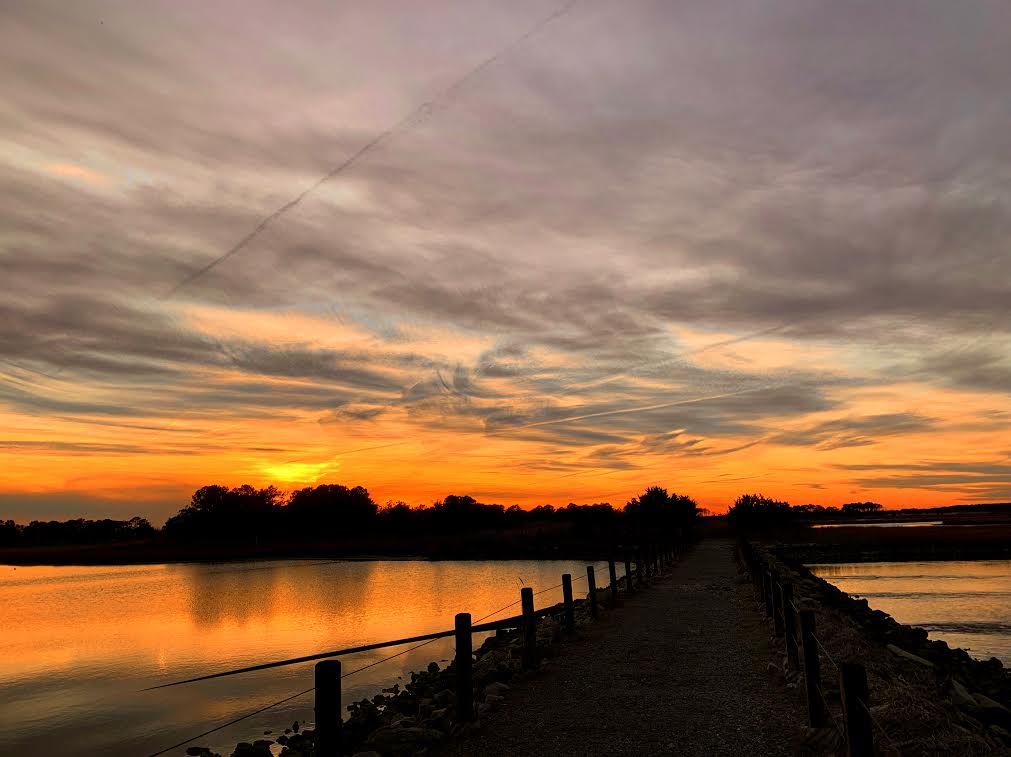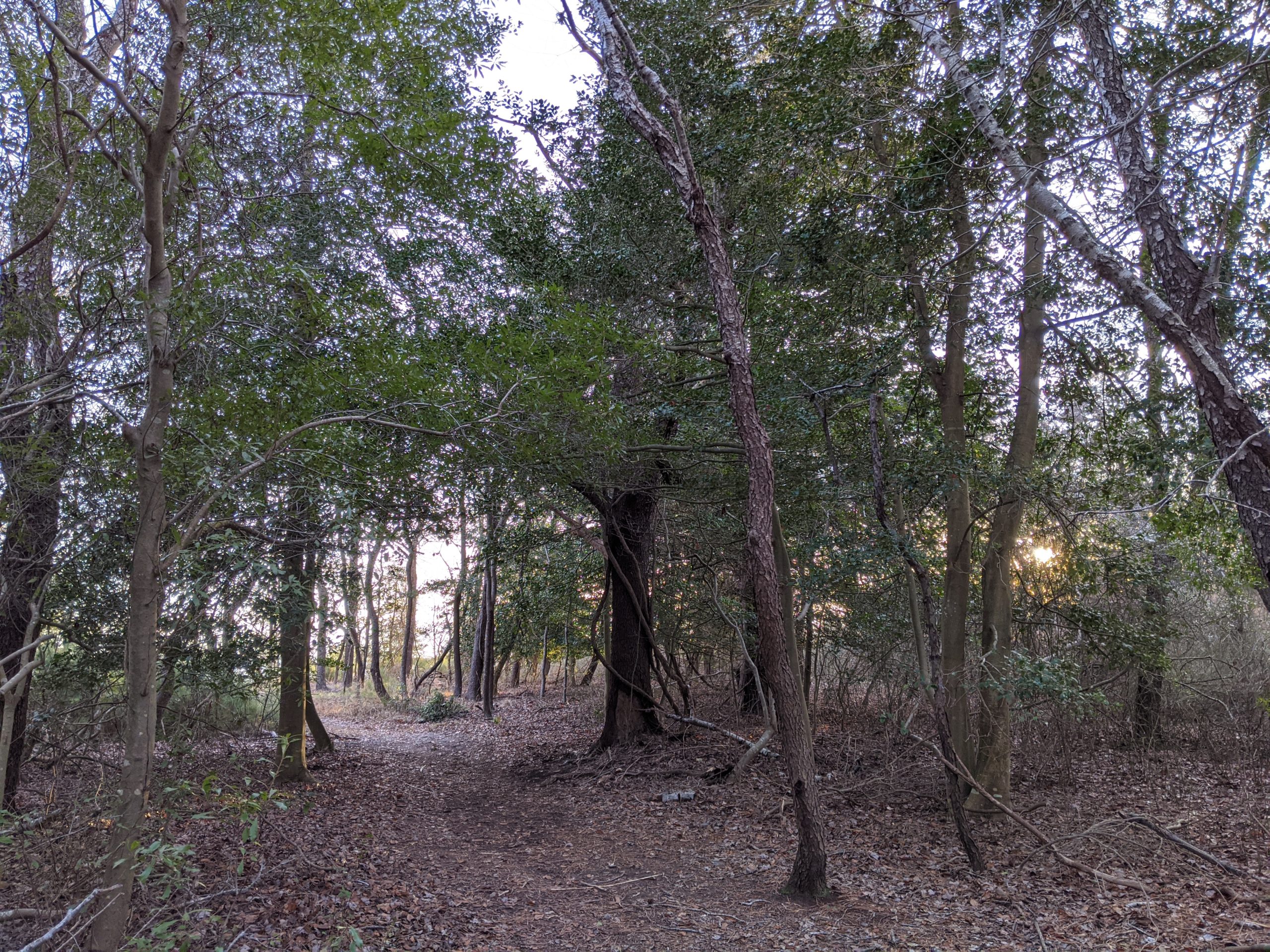
June 1, 2020
By: Kenneth Horowitz, Interpreter at Delaware Seashore State Park
Burton Island is a lonely place. Despite being in the middle of the Rehoboth and Indian River
Bays, it hardly sees any visitors. A mix of the high ground supporting a maritime forest and low-lying salt
marsh, today’s Burton Island is a nature preserve connected to the mainland by a hiking trail. In the
summer, the trail sees far, far more ticks than actual hikers – for that reason, it’s best to plan your visits
to the island for the colder months!

2020, a January sunset on Burton Island
Legends of Burton Island
Despite the island’s lonely disposition today, it has a long history one wouldn’t expect at first glance. Not too long ago, wealthy people from northern cities would travel for days just to reach the island. Before that, it provided the perfect location for an early colonial farm.
Burton Island is even source of some local legends people repeat even today.
For many who grew up around the bays, legend had it that Burton Island was at once connected
to the mainland, with the Long Neck peninsula. According to the legend, a farmer dug ditches to keep
his livestock on the island from straying. Over time, these ditches grew and turned the land into a true
island. Early maps from the period show that this legend is just a myth, but because of this myth, the
waterways between Burton Island and Long Neck are today known as the Big and Little Ditches, with
Middle Island (appropriately) in the center.

1779, “A chart of Delaware Bay, with soundings and nautical observations” shows a large island by the inlet
History of Burton Island
The first owner of the island in the colonial period was William Burton. William was a
wealthy landowner on the peninsula, owning several large tracts of land in Virginia and Maryland.
In 1677 he also gained 1,000 acres of land on Long Neck. He sold half of that land to one Thomas Bagwell,
but his son John Burton inherited the remaining half. One of his descendants, a Stratton Burton,
inherited the islands. The first time the island is named on a map, it is known as “Straten’s” (Stratton’s)
Island.

1801, “A map of the state of Delaware and the Eastern Shore of Maryland: with the soundings of the Bay of Delaware”
showing “Straten’s” Island.
With so many Burtons around in the 1700s, it probably made more sense to call it by the
owner’s first name instead of his last! In this time period, the island was used for farming. The bay
created a natural fence to keep livestock from wandering away, and because most produce was shipped
out of the nearby inlet it was a prime location for a farm. By the 1840s, locals had taken to calling old
Stratton’s island “Burton Island,” and the name has stuck.

1840, Sussex County Orphan’s Court map from the estate of Isaiah Burton, showing Burton Island. A storehouse is located
on the pond, and a bridge runs over the “gut” in the center.
The island continued to be passed down through the same family until 1875 when one Charles
H. Lingo married Serene Burton, who had just inherited the land. Since Charles already had his own
land for his family, they decided to sell the island. To their surprise, a New York real estate developer
approached them and offered to take it off of their hands.
The sly Garret V.W. Eldert had made a small fortune developing Rockaway Beach on Long
Island and it had come to his attention that hunting clubs for wealthy northern patrons were taking off
all across the Delmarva peninsula. Men of means from New York City, Philadelphia, and other big
cities took the new railroad down the Eastern Shore and spent a few days at a time “gunning” (hunting)
and fishing in the bays and marshes along the rugged coastline, just to get away from it all. In 1883,
Eldert bought Burton Island and some land on Long Neck to create a hotel for New Yorkers who were
looking to get out of the big city and enjoy the same activities many visitors to the park enjoy today!

2020, the maritime forest of Burton Island – a big draw for “gunners” in the 1800s!
This “New York Club” was run by Rehoboth’s Harry W. Palmer, and was popular with
sportsmen and sailboat enthusiasts alike. When Eldert died in 1890, his son inherited the island and was
not terribly interested in keeping it. In 1902, a Philadelphia hunting club called the Sport Royal Club
took over the hotel on the island. For the next decade, groups of Philadelphians would trek down to the
Delaware coast to spend a week or more on Burton Island.
The club lost its popularity by the early 1920s, so in 1925 the island was bought by a
Philadelphia businessman – Linford P. Faucett. Faucett had grown up in Georgetown and frequently
returned home to spend his summers on the Indian River. For him, it was a dream come true. When the
Indian River Inlet was being stabilized in 1928, he offered to allow the dredge spoil on his land – so a
large channel was created to force the inlet to stay in place, and Burton Island became connected to the
sandy beach nearby.

1943 US Geological Survey, showing the sand spoil that connected Burton Island to the beach
After Linford’s death in 1931, few people ever visited Burton Island. His son, Benjamin
Faucett suggested in 1934 that the now-abandoned island should become a nature preserve. Sadly,
nothing ever came of the idea because of Benjamin’s untimely death from a farming accident. Local
boat owners were also eyeing the new inlet as a prime location for a marina. In 1946, the Indian River
Yacht Basin began operations after leasing the land and dredging a connection from Balder’s Pond to
the inlet channel.
In 1971, Delaware agreed to purchase Burton Island from Linford Faucett, grandson of the first
Linford, to add to the new Delaware Seashore State Park. Burton Island, once visited by the rich of
both Philadelphia and New York City and abandoned to all but the occasional curious visitor finally
became protected land. In the late 1980s, a bridge connected it to the marina, and a trail with
boardwalks over the marsh was completed. In 2004, it became a full-fledged nature preserve.

1970, aerial photo of Burton Island.
Burton Island Today
Burton Island’s is a quiet history; the clubhouses are long gone, as is the colonial-era farm. Today, it
still makes a great place to get away from it all, right in the center of the inland bays – just make sure to
visit the trail when it’s cold out, or you may take some of the island’s residents home with you!

2020, a park interpreter leads a January hike across the marsh at sunset.


